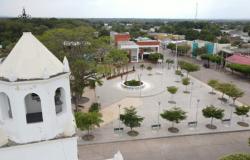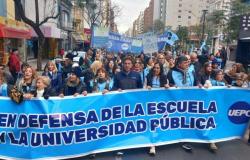This Monday morning, the Minister of Public Works, Jessica Lopezsupervised preventive work on the Santiago sewer network, within the framework of the frontal system forecast for the next few days in the central-southern area of the country.
From Ñuñoa, the Secretary of State detailed the points that could present more complications in the Metropolitan Region, starting with the Santa Marta Channelin the commune of Maipú: “Probably the machines are already installed there, where permanently – that is a floating garbage dump in reality – there in “At the intersection with Camino a Melipilla, water begins to accumulate.”.
“And we have other points throughout the city, which the Directorate of Hydraulic Works (DOH) permanently monitors,” López added, mentioning secondly the Macul ravine. In that basin, the DOH “built tremendous infrastructure to mitigate the force of the flows and direct the water through all the cities.”
“It is an infrastructure that, if you look at it on Google Maps, you can see how the water is conveyed through the city’s canals until it reaches the Víctor Jara flood parkwhich precisely, as its name says, is designed – we are entering the last stage of its construction – to receive rainwater from the Quebrada de Macul,” he added.
Likewise, the minister pointed to the Ramon Gorgewhose course flows between the communes of Peñalolén and The Queen: “It is part of the flow and channel protection infrastructure that the Ministry of Public Works is in charge of, and which has its own path to evacuate these flows, also through the city of Santiago.”
“So, There are several critical points that are becoming less critical every day, because we are creating infrastructure to work on them.”, he stressed.
In the instance, the head of Public Works also referred to the report that the National Disaster Prevention and Response System (Senapred) asked the MOP to assess the risk in the area of the building Euromarina II of Reñacain the Valparaíso Region, which was affected by a sinkhole over the weekend.
“What Senapred has asked us and we have naturally agreed, is to coordinate a working group that aims to make a slightly deeper analysis, and with a more long-term sense, regarding what it means to have all these constructions and real estate developments in the dune areas. We have already experienced this directly from the Ministry last year with the sinkhole (in the Kandinsky building), and now another situation arises in another building,” he said.
Regarding Senapred’s request, he said that they agreed to coordinate a table “where all public and also private organizations, universities, participate, which allow us to have some path of action, because this is already being repeatedthis that in short there may suddenly be failures in some engineering or because climate change brings conditions that were not foreseen in our infrastructure, and it is good that we get ahead of that.”
In addition, the Secretary of State said that she cannot assure that the collectors in the Valparaíso Region will not present new problems or that another sinkhole may be generated, since that will depend ““What are the characteristics and patterns of rain that we face?”and pointed to climate change: “The most complicated thing is the increase in temperature, the change in rain patterns, which mean very violent rains in short periods of time and The infrastructure is not designed for that. Therefore, we are always at risk, and what we have to do then is prepare and anticipate new forms of infrastructure.”







